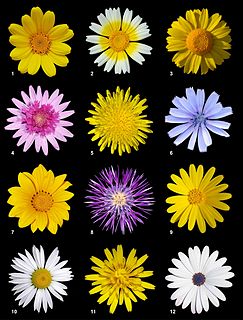
The family Asteraceae, alternatively Compositae, consists of over 32,000 known species of flowering plants in over 1,900 genera within the order Asterales. Commonly referred to as the aster, daisy, composite, or sunflower family, Compositae were first described in the year 1740. The number of species in Asteraceae is rivaled only by the Orchidaceae, and which is the larger family is unclear as the quantity of extant species in each family is unknown.

Euphorbia is a very large and diverse genus of flowering plants, commonly called spurge, in the spurge family (Euphorbiaceae). "Euphorbia" is sometimes used in ordinary English to collectively refer to all members of Euphorbiaceae, not just to members of the genus. Some euphorbias are commercially widely available, such as poinsettias at Christmas. Some are commonly cultivated as ornamentals, or collected and highly valued for the aesthetic appearance of their unique floral structures, such as the crown of thorns plant. Euphorbias from the deserts of Southern Africa and Madagascar have evolved physical characteristics and forms similar to cacti of North and South America, so they are often incorrectly referred to as cacti. Some are used as ornamentals in landscaping, because of beautiful or striking overall forms, and drought and heat tolerance.

Eschscholzia is a genus of 12 annual or perennial plants in the Papaveraceae (poppy) family. The genus was named after the Baltic German/Imperial Russian botanist Johann Friedrich von Eschscholtz (1793–1831). All species are native to Mexico or the southern United States.

Helianthus is a genus comprising about 70 species of annual and perennial flowering plants in the daisy family Asteraceae commonly known as sunflowers. Except for three South American species, the species of Helianthus are native to North America and Central America. The best-known species is the common sunflower, whose round flower heads in combination with the ligules look like the Sun. This and other species, notably Jerusalem artichoke, are cultivated in temperate regions and some tropical regions as food crops for humans, cattle, and poultry, and as ornamental plants. The species H. annuus typically grows during the summer and into early fall, with the peak growth season being mid-summer.

Cerastium arvense is a species of flowering plant in the pink family known by the common names field mouse-ear and field chickweed. It is a widespread species, occurring throughout Europe and North America, as well as parts of South America. It is a variable species. There are several subspecies, but the number and defining characteristics are disputed.

Achyronychia is a monotypic genus of flowering plant containing the single species Achyronychia cooperi, which is known by the common names onyxflower and frost-mat. This plant is native to the Mojave and Sonoran Deserts of northern Mexico and the U.S. states of California, Nevada, Utah and Arizona. In California, it is known from San Diego, Imperial, Riverside, Los Angeles, San Bernardino and Inyo Counties. In Arizona, it occurs in Yuma, Mohave, Pima, Pinal and Maricopa Counties. It has also been reported from Washington County in Utah, and from Clark County, Nevada.
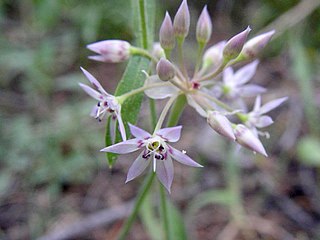
Allium campanulatum is a species of wild onion known by the common name dusky onion or Sierra onion. This is a flowering plant native to the western United States from southeastern Washington and northern Oregon to southern California, and western Nevada. The dusky onion grows in foothills and mountains, especially in dry areas, such as chaparral habitats.

Ceanothus cuneatus is a species of flowering shrub known by the common names buckbrush and wedgeleaf ceanothus.

Croton californicus is a species of croton known by the common name California croton. This plant is native to California, Nevada, Utah, Arizona, and Baja California, where it grows in the deserts and along the coastline.

Draba densifolia is a species of flowering plant in the family Brassicaceae known as the denseleaf draba. This small perennial is native to western North America, where it is found in mountain environments above 2000 meters from California to Alaska to Wyoming. The plant forms cushion-like mats of small fleshy, hairy, pointed leaves in rocky crevices and on slopes. If it bolts a stem it is no taller than 15 centimeters. The flowers open in an obvious inflorescence of a few tiny blooms at times, but often appear as a layer on the surface of the mat of tiny leaves. The flowers are bright yellow with petals just a few millimeters wide. The fruit is a flat podlike silique less than a centimeter long.
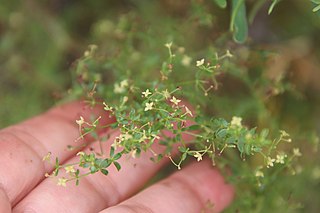
Galium porrigens is a species of flowering plant in the coffee family known by the common names graceful bedstraw and climbing bedstraw. It is native to the west coast of North America from Oregon to Baja California.

Arctostaphylos nummularia is a species of manzanita known by the common names glossyleaf manzanita, dwarf manzanita and Fort Bragg manzanita. It is endemic to California, where it grows in the forests of the coastal and inland ranges north of the San Francisco Bay.
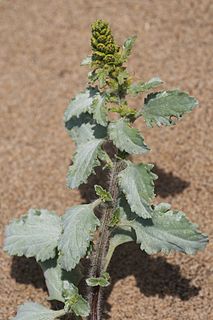
Ambrosia chamissonis is a species of ragweed known by the common names silver burr ragweed, silver beachweed and (silver) beach bur(r).

Arctostaphylos nummularia subsp. mendocinoensis, commonly known as pygmy manzanita, is a subspecies of manzanita. It is endemic to Mendocino County, California and Sonoma County, California, where it is known from only one occurrence in the pygmy forests along the coastline.
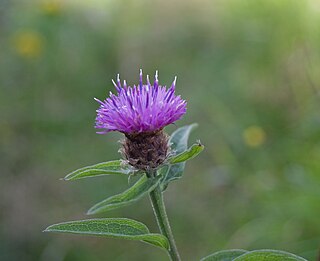
Centaurea nigra is a species of flowering plant in the daisy family known by the common names lesser knapweed, common knapweed and black knapweed. A local vernacular name is hardheads.
Minuartia pusilla is a species of flowering plant in the family Caryophyllaceae known by the common names annual sandwort and dwarf stitchwort.

Psilocarphus brevissimus is a species of flowering plant in the family Asteraceae known by the common names short woollyheads, woolly marbles, and woolly heads.
Psilocarphus elatior is a species of flowering plant in the family Asteraceae known by the common names tall woollyheads, meadow woollyheads and tall woolly-marbles. It is native to the Pacific Northwest in western North America from Vancouver Island, where it is known from just a few occurrences, to northern California. It grows in seasonally moist spots such as meadows, spring seeps, and vernal pools.

Tamarix parviflora is a species of tamarisk known by the common name smallflower tamarisk.

Greasewood is a common name shared by several plants:


















